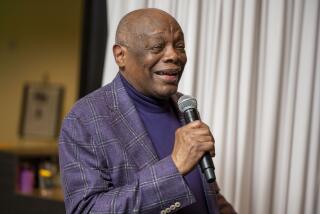‘The James Brown Reader,’ edited by Nelson George and Alan Leeds
The James Brown Reader
50 Years of Writing About the Godfather of Soul
Edited by Nelson George and Alan Leeds
Plume: 318 pp., $17 paper
WHAT would the late James Brown make of Barack Obama? Most definitely, Brown would say he was down with the message of hope and would go on to say James Brown was the man who invented hope back when Obama was in short pants. He’d mock Obama’s prim ways with a plateful of greasy American road food but be impressed with his discipline. The man who mentored Al Sharpton would have known how to box out Jeremiah Wright.
But first and foremost -- one takes away from “The James Brown Reader: 50 Years of Writing About the Godfather of Soul” -- Brown would tell Obama one thing. Bowling, like sex and talking to the press and everything else in this man’s man’s man’s world, is a full-contact sport. You don’t dabble, you don’t mess around, if you want to win. When all eyes are on you -- as they were at a March campaign stop at an Altoona, Pa., bowling alley -- is not the time for a casual display of whatever-whatever. A writer hanging out with Brown in the 1980s describes watching him playing a game of pool with a friend he hadn’t seen in a long time. That boyhood pal turns out to have held on to his pool-playing skills better than Brown, who gets humbled at the table. The words he utters under his breath -- not so sotto voce that the reporter couldn’t write it down -- would straighten the curliest hair.
Brown was the first black president, self-appointed before Bill Clinton won the old-fashioned way. He is as great an artist as America produced in the 20th century. Who else you got? Pollock? Ellington? Pynchon?
Brown capitalized on rhythm and blues when it was seen as grown-up music and followed it as it took harbor in the newly invented culture of the American teenager. He shaped soul and gave birth to funk and hip-hop. Through longevity, reach and connection to the life Americans lived, he gave and gave and gave -- till it hurt, as they say. Except, for Brown, the hurt preceded the giving and followed him to the grave.
And lord, could he communicate. Brown was a talker. He evaded interviewers and then gave them long, grandstanding arias of words. He didn’t so much answer their questions as engage them in combat and try out different strategies of self-explanation. He called himself a messiah and a sinner, and the mood was so heavy as the tape recorders ran that he outstripped any contradiction. His performances for the press whom he had kept waiting until 3 in the morning were almost as important to his myth as the stage performances that preceded them. Brown babbled on; he was a regular on Johnny Carson and showed up on “The Mike Douglas Show.”
And yet Brown makes no sense at all. He endorsed Hubert Humphrey in 1968 and Richard Nixon in 1972. He attacked racism and spoke at civil rights rallies yet embraced onetime segregationist governor of Georgia Lester Maddox. He criticized black nationalists while declaring America was backward compared to the black revolution happening in Africa. Heck, he recorded “Say It Loud -- I’m Black and I’m Proud” and “America Is My Home” in the same year!
James Brown had a lot of explaining to do, so it’s no wonder he talked so much; and when he died on Christmas in 2006, it was fitting that his longtime emcee Danny Ray draped a cape across his body at his funeral. The gesture served as a curtain lowering on a man who surprised no one more than himself. Brown’s life story has so far thwarted Hollywood; Spike Lee reportedly has put the film rights in deep freeze, probably pondering how the heck to make sense of the incomprehensible. These days it seems more likely that the fight over his estate will get made into a movie than will the life of this protean American.
One of the book’s editors, Nelson George, has been one of the most successful and passionate chroniclers of black music for several decades. But the engine behind this book and surely the deepest reason for its quality is the involvement of Alan Leeds. A young DJ in Virginia when he first met Brown in the 1960s, Leeds became Brown’s friend, exasperated associate and road manager in the ‘70s. Leeds went on to work for Prince, D’Angelo and currently Chris Rock; forget an anthology, the man has a great novel in him, a chronicle of life on the road spent serving some of the biggest masculine egos on Earth.
The book starts with a few undistinguished early pieces from the 1950s black press. At the end come two massive reports from this century: Philip Gourevitch’s lengthy 2002 New Yorker profile and a Rolling Stone piece in 2006 by novelist Jonathan Lethem that offers a fascinating window on Brown’s interactions with his musicians in the studio. But the heart of the book is what comes between -- between the time Brown was a little-known Georgia performer with mile-high hair and a star ready for his postage stamp.
The book’s best parts feature revealing portraits of the man at the peak of his powers. Writers as varied as Albert Goldman, Cliff White and Thulani Davis sound like they are describing three different monuments. There is an extraordinary 1966 New York Herald-Tribune profile by Doon Arbus, daughter of photographer Diane Arbus. Full of new-journalism pixilation, it’s perhaps the earliest image we have of a man struggling to control how others represented him. What’s fascinating about the piece is how Brown was even then trying to skew the coverage, only to lose the battle to a 21-year-old writer. And what’s doubly impressive about this book, given the nature of most such efforts and the passion the editors have for Brown’s music, is that they do not seek to tidy up the man. There is crime-scene reporting here. Think of JFK’s not leveling with Americans about his health -- problematic, sure, but also stoic and tactful. Though it’s tempting to sweep the darkness under the rug, the editors never succumb to this kind of legacy building.
James Brown did the mashed potato all over the people closest to him, the musicians and partners and relatives whom he relied on and competed with. The fragments of his image that are not flattering don’t come from tabloid journalists but from those who saw him most clearly. Leeds and George help us understand that Brown deserves a full accounting and assume correctly that readers are capable of understanding that a great artist has many chambers, not all of them decorous. He can stand it, if we can. *
More to Read
Sign up for our L.A. Times Plants newsletter
At the start of each month, get a roundup of upcoming plant-related activities and events in Southern California, along with links to tips and articles you may have missed.
You may occasionally receive promotional content from the Los Angeles Times.






